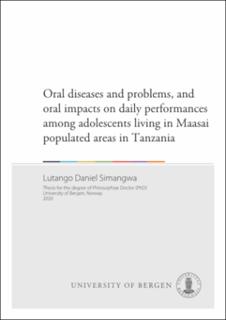Oral diseases and problems, and oral impacts on daily performances among adolescents living in Maasai populated areas in Tanzania
Doctoral thesis

Åpne
Permanent lenke
https://hdl.handle.net/11250/2712441Utgivelsesdato
2020-12-14Metadata
Vis full innførselSamlinger
Sammendrag
Background: The study aimed to assess prevalence/frequency and socio-behavioral distribution of oral diseases/problems and their oral quality of life consequences according to Maasai and non-Maasai ethnic groups.
Methods: All adolescents in the selected classes from 23 randomly selected schools were invited to participate in an interview and clinical oral examination.
Results: The observed prevalence in percentage of different oral diseases/problems among adolescents was 65.6, 40.9, 8.8, 48.6, 1.9, 16.5 and 11.8 for poor oral hygiene, gingival bleeding, dental caries (DMFT>0), severe dental fluorosis (TF grade 5-9), dental erosion into dentin, tooth wear into dentin and Temporomandibular disorder (TMD), respectively. The prevalence of Oral Impact on Daily Performance (OIDP>0) was (15.8%). From multiple variable analyses, adolescents from Longido and girls were more likely to present good oral hygiene (p<0.05). Males and adolescents from Maasais presented more gingival bleeding than females and adolescents from non-Maasais (p<0.05). Age and non-Maasai ethnic group were associated with DMFT>0 (p<0.05). Dental erosion was more common among non-Maasais (p<0.05). Regular tooth cleaning was associated with less gingival bleeding (p<0.05). Severe dental fluorosis was associated with the use of magadi in food (p<0.05). Clenching/grinding teeth was the only covariate for TMD (p<0.05). Regarding OIDP, adolescents from Longido district and adolescents with good oral hygiene were less likely to report OIDP>0, but non-Maasai, those with DMFT>0 and 2Q/TMD>0 were more likely to report OIDP>0 (p<0.05).
Conclusion: Among the study participants, the most common findings were gingival bleeding, dental fluorosis, tooth wear and TMD, less common findings were dental caries and dental erosion. The prevalence of oral impacts was moderate. This study confirmed socioeconomic and oral clinical disparities in OIDP. These results are important for public oral health decision makers in Tanzania.
Består av
Paper I: Simangwa LD, Åstrøm AN, Johansson A, Minja IK and Johansson AK. Oral diseases and socio-demographic factors in adolescents living in Maasai population areas of Tanzania: a cross-sectional study. BMC Oral Health.2018;18:200. The article is available at: https://hdl.handle.net/1956/20294Paper II: Simangwa LD, Åstrøm AN, Johansson A, Minja IK and Johansson AK. Oral diseases and oral health related behaviors in adolescents living in Maasai population areas of Tanzania: a cross-sectional study. BMC Pediatrics. 2019;19:275. The article is available at: https://hdl.handle.net/1956/23590
Paper III: Simangwa LD, Johansson AK, Johansson A, Minja IK and Åstrøm AN. Oral Impacts on Daily Performances and its socio-demographic and clinical distribution: A cross-sectional study of adolescents living in Maasai population areas, Tanzania. Health Qual Life outcomes. 2020;18:181. The article is available in the thesis file. The article is also available at: https://doi.org/10.1186/s12955-020-01444-7